The Versatility of the Sleeping Head Wrap: An In-Depth Exploration
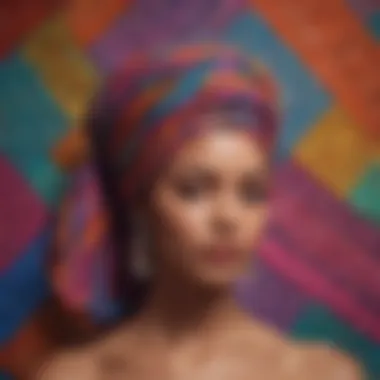
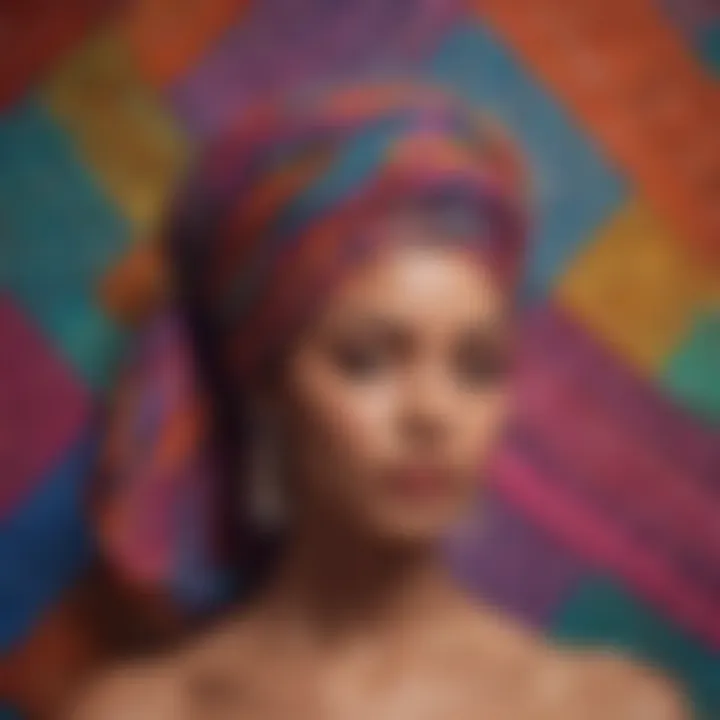
Intro
Sleeping head wraps serve an important role in both fashion and personal care today. They are not just practical accessories that women use to protect and manage their hair, but they also elevate one’s style. This article explores the origins of head wraps, their cultural significance, and practical benefits in daily life. Readers will learn how to utilize these wraps not only for functionality but also for enhancing beauty routines. The ongoing evolution of designs reflects the changing trends and preferences in society.
Understanding sleeping head wraps can provide insights into identity, comfort, and even health. By examining various styles and the best practices in using them, women can find the perfect head wrap that suits their lifestyle. This article aims to bridge the gaps between practicality, style, and self-expression through the lens of sleeping head wraps.
Fashion Trends
Seasonal Styles
The world of fashion embraces the sleeping head wrap, adapting its styles to fit the seasons. In winter months, warmer fabrics like flannel or velvet are favored, providing both coziness and elegance. The deep colors and rich textures of these materials resonate well with the chill in the air.
As spring arrives, lighter fabrics such as cotton or linen become popular choices. They allow for breathability while still maintaining a chic appearance. Pastel colors and floral patterns characterize this season, adding freshness and vibrancy to any outfit.
During summer, many opt for bold prints and bright colors. Lightweight wraps become essential as they protect hair from sun damage while still being a fashionable statement. The ease of styling a head wrap during summer activities shows its versatility in hot weather.
Fall presents a unique opportunity to mix and match textures and layers. Combining a head wrap with scarves or hats can create a fashionable look that is both warm and stylish. Fall colors like burnt orange or deep green add a seasonal touch that resonates with the environment.
Influencer Inspirations
Social media influencers play a crucial role in shaping the trends surrounding sleeping head wraps. Their styles and creativity inspire women across the globe. Followers often look to these influencers for new ways to wrap their hair.
Many use Instagram or TikTok to showcase their unique adaptations. Tutorials from influencers can help women learn different wrapping techniques that appeal to various occasions. For example, some influencers might favor more structured styles for formal events, while others may prefer laid-back, casual looks for everyday wear.
Through these platforms, preferences for specific brands or patterns can spread rapidly. Women observe what styles are trending and find their inspiration, leading to a rich diversity in styles adopted by the broader community.
"Influencers have transformed the sleeping head wrap from a practical item into a statement piece. They show how details in wrapping can express individuality."
Beauty Tips
Skincare Routines
While using a sleeping head wrap is beneficial for hair, it can also align with skincare routines. Many women find that wearing a wrap at night helps prevent friction on the skin, which can lead to fewer breakouts. Wearing natural fabrics like silk can be particularly kind to the skin, promoting better moisture retention.
Additionally, some women tie their head wraps while applying nighttime skincare products. It can help in keeping hair products from transferring onto the face, allowing for a focused application of creams and serums. Nighttime routines become easier and more efficient by combining the two practices.
Makeup Techniques
In terms of makeup, a head wrap can serve a crucial role. It keeps hair away from the face, allowing for a clear view while applying makeup. For those who are experimenting with bold looks, such as vivid lipstick or dramatic eye makeup, head wraps can help avoid smudging.
On days when minimal makeup is preferred, a stylish head wrap can be the focal point of an outfit. Choosing a vibrant or patterned wrap can distract from the need for elaborate makeup. This advantage appeals to women seeking to balance simplicity with elegance.
Product Reviews
Trending Products
When choosing head wraps, various products have emerged in the market catering to different preferences. Brands like Wrap Life and The Wrap Life offer a range of options in both design and functionality. These companies emphasize quality materials that support both style and comfort.
Silk or satin wraps are notable for their luxurious feel and hair benefits. They help to reduce breakage and maintain moisture in hair while providing a touch of elegance. On the other hand, cotton wraps create a more casual vibe, making them perfect for everyday wear.
Comparison Guides
When selecting a sleeping head wrap, a few key features can make a significant difference:
- Material: Consider if silk, satin, or cotton suits your needs.
- Size: Larger wraps may allow for more styling options, while smaller ones can be more convenient.
- Design: From bold patterns to subtle colors, choose one that reflects your personal style.
- Care Instructions: Fabrics require different levels of maintenance.
By weighing these factors against personal preferences, women can choose the head wrap that best aligns with their beauty and hair care routines.
Foreword to Sleeping Head Wraps
Sleeping head wraps are more than just a fashion accessory; they encapsulate a blend of cultural heritage, personal care, and contemporary style. The importance of this topic lies in its multifaceted approach to exploring how these simple yet significant fabric wraps can alter routines and enhance personal aesthetics. Not only do sleeping head wraps offer practical benefits for maintaining hair health, but they also serve as a canvas for self-expression.
Definition and Purpose
A sleeping head wrap is typically a fabric piece worn around the head during sleep. Its primary purpose is to protect hair from friction against the pillow, which can lead to breakage, split ends, and loss of moisture. Many women use these wraps to maintain their hairstyles for longer periods and to prevent tangling overnight. The various materials, such as cotton, satin, or silk, contribute to different beneficial properties.
Moreover, these head wraps can also create a warmer environment for the scalp, which some people find comforting. Beyond the practical aspects, the sleeping head wrap can be a cultural statement or a reflection of one's personal style. Its significance extends to a broad audience, allowing for individual expression while serving a specific function.
Historical Context
The historical context of sleeping head wraps reveals a rich tapestry of usage across different cultures. For centuries, head wraps have been prominent in African, Middle Eastern, and various indigenous cultures. They were often symbols of status, beauty, and cultural identity. In many African societies, for example, head wraps are known as "gele" in Nigeria and "doek" in South Africa. These wraps played vital roles in rituals and daily life, signifying femininity, respectability, and sometimes, marital status.
As societies evolved, so did the styles and purposes of these wraps. In modern times, they have transcended cultural boundaries, gaining popularity in fashion and personal care. Many women embrace the sleeping head wrap not only for its historical roots but also for its ability to blend tradition with contemporary beauty practices. The adoption of these wraps signifies a return to heritage for some while allowing others to explore new ways of caring for their hair.


Cultural Significance
The cultural significance of sleeping head wraps extends beyond mere fashion or practicality; it encompasses a rich tapestry of history, identity, and symbolism. For many, these wraps are not only accessories but also a profound expression of cultural heritage. They reflect traditions that have been passed down through generations, often becoming intertwined with personal identity and societal roles. By understanding the cultural significance of head wraps, individuals can appreciate their deeper meanings and the narratives they carry.
Origins in Various Cultures
Sleeping head wraps boast a diverse origin, emerging in various cultures around the globe. This accessory has historical ties to regions such as Africa, the Middle East, and even Europe.
For instance, in African cultures, head wraps serve many purposes. They are often worn as a form of protection for the hair, but more significantly, they can signify marital status, social rank, or tribal affiliation. In some societies, particular styles or colors may denote specific cultural practices or religious beliefs. Furthermore, these wraps are prevalent in ceremonies, celebrations, and daily life, cementing their place in cultural expressions.
In the Middle East, head wraps, such as hijabs, provide a combination of cultural significance and modesty. They reflect both religious adherence and strong cultural tradition, illustrating the profound connection between style and identity. Meanwhile, in Europe, head wraps have historically been used for practical reasons, such as protection against wind and dust, while also becoming associated with fashion trends throughout the centuries.
Head Wraps as a Symbol of Identity
Beyond their functional applications, sleeping head wraps have evolved to serve as a powerful symbol of identity for many individuals. When donned, head wraps can express personal beliefs, cultural pride, and community affiliations.
For women, these accessories often convey messages of empowerment and resistance. In recent years, head wraps embraced as a fashionable statement have seen resurgence in mainstream culture. This resurgence enables women to reclaim and celebrate their heritage while challenging beauty standards imposed by society. Wearing a head wrap can be an act of defiance against stereotypes, enhancing the wearer's sense of belonging and confidence.
"Head wraps are a connection to our roots; they allow us to express who we are and where we come from."
Benefits of Wearing a Sleeping Head Wrap
Wearing a sleeping head wrap provides numerous advantages that extend beyond mere aesthetics. These benefits encompass practical hair care, comfort during sleep, and a variety of personal choices that influence health and wellness. Understanding these elements can guide individuals in making informed decisions about their beauty routines.
Protection for Hair
Preventing Breakage
One of the significant benefits of wearing a sleeping head wrap is its ability to prevent breakage. Hair, especially in textured forms, is vulnerable to friction against pillowcases during sleep. This friction can weaken hair strands, leading to split ends and breakage. A head wrap acts as a protective barrier, reducing direct contact and minimizing the mechanical stress on the hair.
The key characteristic of this benefit is its proactive approach to hair maintenance. By using a sleeping head wrap consistently, individuals can maintain the integrity of their hair and promote healthier growth over time.
The unique feature of preventing breakage lies in its suitability for all hair types. While it is especially beneficial for curly and coily textures, straight hair can also benefit from reduced friction. Overall, this aspect provides an essential layer of care for users who prioritize their hair's health.
Retaining Moisture
Equally important is the head wrap's role in retaining moisture. Hair requires proper hydration to remain healthy, pliable, and shiny. Cozying up a sleeping head wrap helps lock in moisture that might otherwise escape during the night. This is particularly crucial for individuals with naturally dry or curly hair, as their moisture retention needs are higher.
The core advantage of retaining moisture is that it supports the hair’s essential oils. When the moisture levels are maintained, users experience fewer frizz issues and a more manageable texture. Moreover, this effect enhances overall appearance and can significantly reduce the need for additional products.
Unique to this benefit is the interplay between fabric choice and moisture retention. For instance, satin or silk head wraps often outperform standard cotton due to their smoother surfaces that cause less moisture absorption. Using the right material can thus elevate moisture retention results, making this choice both practical and beneficial for maintaining hair health.
Comfort During Sleep
Finally, the comfort provided by sleeping head wraps deserves attention. Many individuals find that wearing a head wrap contributes to a more restful sleep. Whether it is the softness of the fabric or the security of having hair contained, a head wrap can create a sense of comfort that enhances sleep quality.
The comfort that comes from wearing a head wrap is not only about physical ease but also psychological. Knowing that one’s hair is protected might relieve worries, allowing for deeper relaxation. This can result in improved sleep patterns and contribute positively to overall health.
Styles and Materials
Understanding the styles and materials of sleeping head wraps is crucial for choosing the right wrap that meets individual needs. The fabric and design influence not only comfort but also the efficacy of protecting hair during sleep. Each material offers unique properties that cater to different preferences and hair types. This section will delve into popular fabrics and current trends, shedding light on how these choices contribute to the overall experience of using sleeping head wraps.
Popular Fabrics for Head Wraps
Cotton
Cotton is a widely used fabric for sleeping head wraps. Its breathability is one of the main reasons for its popularity. This fabric allows air circulation, making it comfortable to wear throughout the night. Additionally, cotton is a natural fiber, which means it is less likely to irritate sensitive skin.
One of the unique features of cotton is its ability to absorb moisture. This is advantageous for those who prefer a cool feeling as they sleep. However, cotton may not retain moisture in hair as effectively as other fabrics, which may be a disadvantage for individuals focusing on moisture retention.
Silk
Silk is often seen as a luxurious choice for head wraps. It is known for its smooth texture, which reduces friction against hair. This quality helps prevent breakage, making it a preferred option for those with delicate hair types. Silk also has a natural moisture-wicking property, which can aid in maintaining humidity levels in hair, especially beneficial for dry or curly hair.
Despite its many benefits, silk can require more care when washing and maintaining. It can also be on the expensive side, which might deter some individuals from choosing it as their primary material for head wraps.
Satin
Satin is another popular fabric, standing out for its slippery surface. This fabric combines some of the advantages of both cotton and silk. It promotes a comfortable night's sleep while minimizing hair tangling and friction. Satin head wraps are excellent for maintaining hairstyles overnight, and they help with moisture retention in hair.
However, satin can be less breathable compared to cotton, leading to warmth during sleep. For individuals prone to overheating, this could potentially be a drawback.
Current Trends and Innovations
Staying updated with trends and innovations in head wrap styles is essential for both functionality and aesthetics. Recent designs not only serve practical purposes but also allow for personal expression through fashion.

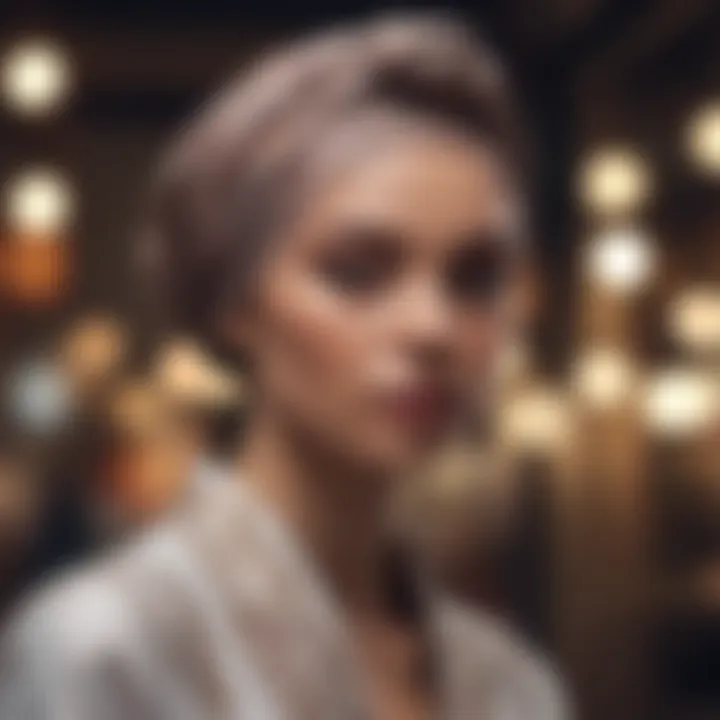
Patterned Designs
Patterned designs in head wraps have gained significant popularity in recent years. These creative and vibrant prints enable wearers to make a fashion statement while addressing hair protection needs. The key characteristic of patterned designs is their diversity in visual appeal, offering options that suit various tastes.
The unique feature of these styles is how they blend traditional elements with modern fashion aesthetics. This versatility means they can be worn not only for sleeping but also as part of daily outfits. On the downside, some patterns may not appeal to all individuals, which could limit their choices.
Eco-Friendly Options
Sustainability has become a trending topic across all fashion genres, and sleeping head wraps are no exception. Eco-friendly materials are becoming increasingly accessible to consumers. These fabrics are often derived from organic or recycled sources, helping to reduce environmental impact. A major advantage of eco-friendly options is their low environmental footprint, which attracts eco-conscious consumers.
Furthermore, they may retain similar properties to traditional fabrics, ensuring performance is not compromised. However, availability and variety might still vary, which can hinder consumers looking for specific styles or designs.
How to Choose the Right Head Wrap
Selecting the right head wrap can significantly influence both the comfort and the effectiveness of its use. The options available become numerous with variations in fabric, size, and style. Understanding what to consider when making a choice can improve the overall experience of using a head wrap. It is not only about fashion but also about functionality.
Consider Your Hair Type
When choosing a head wrap, knowing your hair type is essential. Different hair types respond differently to friction, moisture retention, and overall protection. For instance, individuals with coarse or curly hair may benefit from satin or silk wraps. These materials help to reduce friction against the hair, minimizing breakage and frizz.
Alternatively, those with fine or straight hair might find cotton wraps more suitable. Cotton tends to absorb moisture, which can help keep hair clean and reduce oiliness. Assessing your hair texture, density, and common styling methods can lead to more informed decisions, leading to enhanced hair health.
Selecting the Appropriate Size
The right size of the head wrap is equally critical. A wrap that is too small may slip off during the night, leading to disrupted sleep or insufficient protection for the hair. Conversely, one that is too large can result in discomfort and an unkempt appearance.
To ensure the best fit, measure the circumference of your head. Many brands provide sizing guides based on these measurements. Additionally, consider how you plan to style the wrap. If you desire a more intricate style, a larger fabric piece may be necessary.
In summary, taking into account hair type and wrap size cultivates a more personalized experience. Each individual's needs may vary; therefore, exploration and experimentation with different styles and materials can yield the best results.
"The right head wrap serves not just as a fashion statement, but as an important tool for maintaining hair health and providing comfort throughout sleep."
Integrating these considerations into your choice will enhance both your beauty and self-care routines.
Techniques for Tying Head Wraps
Tying a head wrap is not just a functional skill; it is an expression of creativity and personality. The variations in tying techniques allow individuals to showcase their unique style while also catering to the practical benefits of protecting hair during sleep or adding flair to outfits. Understanding these techniques empowers users to make informed choices about their head wraps based on their needs and preferences.
Basic Tying Methods
Basic tying methods serve as the foundation for any head wrap journey. These techniques are straightforward and can be done quickly, making them ideal for individuals who are new to wearing head wraps.
Here are some key points about basic tying methods:
- Simple Elegance: A basic method can create a chic look without overwhelming complexity.
- Versatility: These techniques can fit various occasions, from casual wear to relaxed sleep.
- Ease of Learning: Even those with little practice can master basic ties in a short amount of time.
Here are some steps to perform a simple tie for a head wrap:
- Prepare the Fabric: Choose a wrap fabric that is comfortable. Cotton is widely preferred for its breathability.
- Position the Fabric: Place the fabric at the nape of your neck, ensuring both ends are equal in length.
- Cross the Ends: Bring the ends of the fabric forward and cross them over each other at the forehead.
- Wrap Around: Continue to wrap the ends around, bringing them back to the nape of the neck.
- Secure the Ends: Tie a knot or tuck the ends securely to avoid slipping.
Advanced Styles for Various Occasions
Exploring advanced tying styles adds layers of complexity and artistic expression to the character of head wraps. While basic techniques provide functionality, advanced styles can elevate a simple head wrap into an elaborate fashion statement.
Consider the following when choosing advanced tying styles:
- Occasion Suitability: Certain styles may be more appropriate for events such as weddings, parties, or cultural gatherings.
- Personal Style: Advanced wraps can reflect personal taste and individuality.
- Comfort: While visually appealing, ensure that the style also remains comfortable for extended wear.
Some popular advanced styles include:
- Bow Ties: Featuring a large bow at the top, this style is playful and great for festive events.
- Turban Styles: Wrapping the fabric in a method that creates a full turban look offers both style and head coverage.
To master an advanced style:
- Choose Your Fabric: For intricate styles, fabrics like silk or satin add elegance.
- Follow a Tutorial: Many online resources can guide through video demonstrations for particular styles.
- Practice: Repeated attempts will help in achieving a polished look, enhancing confidence in wearing head wraps.
"The art of tying a head wrap is a dance between tradition and personal expression. Each style holds its own story."
Adopting these techniques not only allows for versatility in how head wraps are worn, but they also create opportunities for self-expression in daily life.
Incorporating Head Wraps into Daily Routines
Incorporating head wraps into daily routines allows individuals to blend functionality with personal style. These wraps serve multiple purposes, from enhancing hair care to making a fashion statement. Understanding their versatility can help users utilize them effectively in their lives. The emotional and psychological benefits of wearing head wraps cannot be understated; they can foster a sense of pride and identity while promoting self-care.
While Sleeping
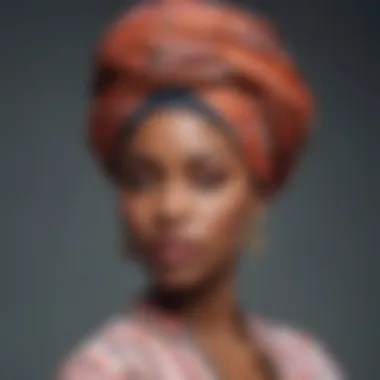
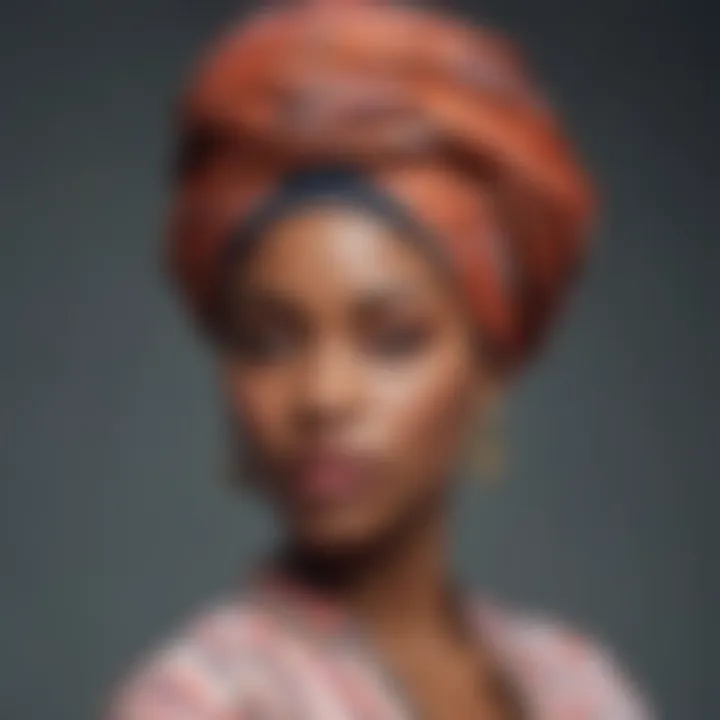
Wearing a head wrap while sleeping offers essential protection for hair health. This practice helps to maintain hair moisture, preventing dryness and breakage during the night. A properly tied head wrap forms a protective barrier against friction from pillows and blankets, minimizing the risk of tangles.
Additionally, using a head wrap can create a conducive environment for sleep. The softness of materials like satin or silk is gentle on the skin and helps regulate temperature, allowing one to value both comfort and personal routine. This is particularly beneficial for women with textured or curly hair, as it helps preserve hairstyles without the use of harsh chemicals or heat treatments.
As a Fashion Statement
Beyond their practical benefits, head wraps have evolved into a chic accessory in contemporary fashion. Women of various backgrounds use these wraps to express their individuality and creativity. Choosing diverse fabrics and patterns can match the head wrap's style to any outfit, from casual to formal.
Furthermore, trends in social media have emphasized head wraps as a staple in integrating cultural identity with modern style. Each wrap carries a story, serving as a canvas for artistic expression.
"Head wraps are not just a functional necessity; they are a symbol of empowerment and style."
In essence, integrating head wraps into daily routines merges practicality with culture and aesthetics. Whether used for health benefits during sleep or as a fashion statement throughout the day, head wraps serve as an indispensable part of many women's lives.
The Health Aspects of Sleeping with Head Wraps
Sleeping with head wraps offers several health benefits that are often overlooked. Not only are these wraps a practical solution for hair care, but they also contribute to skin health. This section examines how using a sleeping head wrap can manage hair health and its impact on skin care during sleep.
Managing Hair Health
One of the primary reasons individuals wear sleeping head wraps is to protect their hair while they sleep. Hair can often become damaged due to friction against pillowcases. The delicate fibers of cotton or satin head wraps help reduce breakage.
- Preventing Breakage: When hair moves against a rough surface, it can cause friction. This friction leads to split ends and breakage, particularly in curly and textured hair. A sleeping head wrap minimizes this risk. The smooth fabric creates a barrier, reducing the chance of hair snagging.
- Retaining Moisture: Different hair types have varying moisture needs. Dry hair is prone to breakage. Head wraps can help maintain moisture levels by preventing the loss of natural oils. Many people report softer and healthier hair after regularly using head wraps.
Using a head wrap is not just a fashion statement; it plays a critical role in preserving hair quality.
Impact on Skin Care During Sleep
Wearing a sleeping head wrap can also influence skin care positively. The relationship between hair and skin is often underappreciated.
- Reduced Acne: Hair products like oils and creams can transfer to your face while resting. This transfer can clog pores and lead to breakouts. A head wrap shields your face from these potential irritants. Thus, it may reduce the incidence of acne for individuals who are susceptible to it.
- Hydration Maintenance: The fabric can also prevent unwanted contact with cotton pillowcases, which absorb moisture. For those who use facial treatments, a head wrap can extend the life of those products by ensuring they stay on the skin longer and not getting absorbed by the pillow.
"Head wraps can have both aesthetic and functional benefits, including hair preservation and better skin health."
Adopting this practice may elevate your hair and skin health, making it a crucial topic for anyone invested in their overall well-being.
Sustainability and Ethical Considerations
In the modern context of fashion and personal care, sustainability has emerged as a critical theme. As the awareness around environmental and social impact grows, the sleeping head wrap becomes not just a personal accessory, but a symbol of ethical responsibility. The production and sourcing methods used for creating head wraps can significantly affect communities, economies, and ecosystems. Addressing sustainability in the context of sleeping head wraps involves recognizing the materials used, the production processes, and the support for local artisans.
Sourcing Sustainable Materials
Choosing sustainable materials is paramount when selecting sleeping head wraps. Fabrics like organic cotton, hemp, and Tencel are excellent options that marry functionality with eco-friendliness. Organic cotton is cultivated without harmful pesticides and chemicals, minimizing the negative effects on both the environment and the farmers' health. Hemp, on the other hand, is naturally resistant to pests and requires minimal water, making it a sustainable crop.
Additionally, Tencel is made from sustainably sourced wood pulp and is known for its softness and biodegradability. Incorporating these materials into head wrap production not only lessens the environmental footprint but also promotes a healthier option for consumers. When shopping for sleeping head wraps, always check for certifications like GOTS (Global Organic Textile Standard) to ensure that the materials are sourced responsibly.
Support for Local Artisans
Supporting local artisans is another crucial aspect of ensuring sustainability in this accessory market. Many head wraps are created by skilled artisans who rely on their craft for their livelihood. Buying from these creators fosters community development and preserves cultural heritage. Often, local artisans use traditional techniques that may not only be environmentally friendly but also support fair trade practices.
When you choose to purchase a head wrap made by local artisans, you are directly contributing to the economic stability of that community. Moreover, the unique touches and designs that come from these artisans often reflect rich histories and narratives, adding a deeper significance to the accessory you wear.
By considering sustainability and ethical aspects when choosing head wraps, consumers make informed choices that benefit not only themselves but also the environment and society as a whole. Supporting sustainable practices ensures the longevity of the fashion industry while honoring cultural values and craftsmanship.
"By choosing to support sustainable materials and local artisans, consumers can champion innovative practices in fashion while making a genuine impact on local economies and the environment."
End
The conclusion of this article serves to synthesize the key insights on sleeping head wraps, their relevance, and the myriad benefits they offer. The importance of sleeping head wraps extends beyond mere aesthetic appeal. They play a significant role in hair protection, comfort, and cultural expression. By wearing a sleeping head wrap, individuals manage hair health effectively, reducing breakage and maintaining moisture. Moreover, the comfort they provide during sleep cannot be understated; many find that head wraps enhance their sleep quality by minimizing friction against the pillow.
Additionally, the cultural significance of head wraps cannot be overlooked. They are not only a practical accessory but also a powerful symbol of identity and tradition, reflecting personal and communal values. Understanding this aspect fosters a deeper appreciation for their use and encourages individuals to wear them with confidence and pride.
Recap of Benefits and Importance
*Enhanced Hair Care: *Sleeping head wraps protect hair from damage.
- Preventing Breakage: This is essential for keeping hair healthy and vibrant.
- Retaining Moisture: Helps to lock in hydration, essential for various hair types.
Increased Comfort: These wraps offer comfort during nighttime, reducing disturbance and improving sleep hygiene.
Cultural Appreciation: Head wraps carry significant cultural weight, connecting wearers to their heritage.
It is clear that sleeping head wraps provide practical benefits while also holding cultural value. This duality makes them a unique and versatile accessory in the world of personal care and fashion.
Encouragement for Exploration
For anyone interested in beauty and personal wellness, exploring sleeping head wraps is highly recommended. Engage with different materials and styles; you might find a new favorite addition to your night routine. Do not hesitate to experiment with various tying techniques and designs that suit your personal taste.
Research is also vital. Look into the history of head wraps to appreciate their evolution and cultural significance. As you incorporate these beautiful accessories into your life, you will not only enhance your hair care regimen but also take part in a rich tradition that spans multiple cultures.
If you are curious, visit websites like en.wikipedia.org or britannica.com for deeper insights. You can also join discussions on platforms like reddit.com, where users share their experiences and tips.



